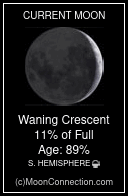| Ice |
A term used to describe water or a number of gases such as methane or ammonia when in a solid state. |
| Inclination |
A measure of the tilt of a planet's orbital plane in relation to that of the Earth. |
| Inferior Conjunction |
A conjunction of an inferior planet that occurs when the planet is lined up directly between the Earth and the Sun. i.e. Sun-Object-Earth in line. |
| Inferior Planet |
A planet that orbits between the Earth and the Sun. Mercury and Venus are the only two inferior planets in our solar system. |
| International Astronomical |
An international organization that unites national astronomical societies from around the world and acts as the internationally recognized authority for assigning designations to celestial bodies and their surface features. |
| Interplanetary Magnetic Fie |
The magnetic field carried along with the solar wind. |
| Interstellar Medium |
The gas and dust that exists in open space between the stars. |
| Intrinsic magnitude |
Absolute magnitude |
| Ionosphere |
A region of charged particles in a planet's upper atmosphere. In Earth's atmosphere, the ionosphere begins at an altitude of about 25 miles and extends outward about 250. |
| Iron Meteorite |
A meteorite that is composed mainly of iron mixed with smaller amounts of nickel. |
| Irregular Galaxy |
A galaxy with no spiral structure and no symmetric shape. Irregular galaxies are usually filamentary or very clumpy in shape. |
| Irregular Satellite |
A satellite that orbits a planet far away with an orbit that is eccentric and inclined. They also tend to have retrograde orbits. Irregular satellites are believed to have been captured by the planet's gravity rather than being formed along with the planet. |

